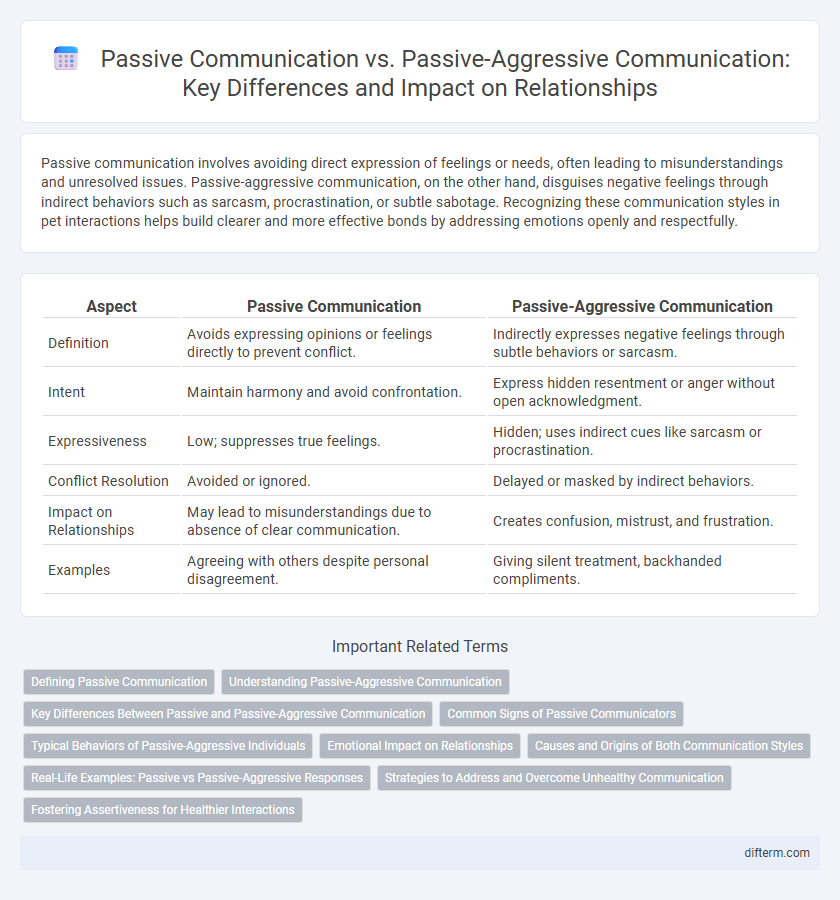Passive communication involves avoiding direct expression of feelings or needs, often leading to misunderstandings and unresolved issues. Passive-aggressive communication, on the other hand, disguises negative feelings through indirect behaviors such as sarcasm, procrastination, or subtle sabotage. Recognizing these communication styles in pet interactions helps build clearer and more effective bonds by addressing emotions openly and respectfully.
Table of Comparison
| Aspect | Passive Communication | Passive-Aggressive Communication |
|---|---|---|
| Definition | Avoids expressing opinions or feelings directly to prevent conflict. | Indirectly expresses negative feelings through subtle behaviors or sarcasm. |
| Intent | Maintain harmony and avoid confrontation. | Express hidden resentment or anger without open acknowledgment. |
| Expressiveness | Low; suppresses true feelings. | Hidden; uses indirect cues like sarcasm or procrastination. |
| Conflict Resolution | Avoided or ignored. | Delayed or masked by indirect behaviors. |
| Impact on Relationships | May lead to misunderstandings due to absence of clear communication. | Creates confusion, mistrust, and frustration. |
| Examples | Agreeing with others despite personal disagreement. | Giving silent treatment, backhanded compliments. |
Defining Passive Communication
Passive communication involves avoiding direct expression of thoughts or feelings, often prioritizing others' needs over one's own to maintain harmony. It is characterized by a reluctance to assert personal rights, leading to unclear or subdued messages that may cause misunderstandings. Unlike passive-aggressive communication, passive communication lacks hidden hostility or indirect resistance.
Understanding Passive-Aggressive Communication
Passive-aggressive communication involves expressing negative feelings indirectly through sarcasm, procrastination, or subtle sabotage, contrasting with passive communication, which avoids confrontation and openly communicating needs. Understanding passive-aggressive behavior requires recognizing hidden hostility masked by seemingly compliant or agreeable interactions. Identifying patterns such as backhanded compliments, intentional inefficiency, and silent treatment helps decode underlying resentment and promotes healthier communication strategies.
Key Differences Between Passive and Passive-Aggressive Communication
Passive communication involves withholding opinions and emotions to avoid conflict, often leading to unresolved issues and internalized frustration. Passive-aggressive communication, however, expresses negative feelings indirectly through subtle actions, sarcasm, or backhanded compliments, creating confusion and tension. Understanding these differences is crucial for improving interpersonal interactions and promoting assertive, clear communication.
Common Signs of Passive Communicators
Passive communicators often exhibit signs such as avoiding eye contact, speaking softly, and hesitating to express their true opinions or feelings. They may frequently apologize, downplay their own needs, and struggle with setting boundaries, leading to internalized frustration. These behaviors contrast with passive-aggressive communication, where underlying resentment is expressed indirectly through sarcasm or subtle sabotage.
Typical Behaviors of Passive-Aggressive Individuals
Passive-aggressive individuals often exhibit behaviors such as procrastination, stubbornness, and intentional inefficiency to express hidden resentment without direct confrontation. They frequently use sarcasm, backhanded compliments, and ambiguous language to mask their true feelings, creating confusion and frustration in communication. This indirect expression contrasts with passive communication, where individuals typically avoid expressing opinions or emotions altogether to maintain peace.
Emotional Impact on Relationships
Passive communication often leads to unresolved feelings and misunderstandings, creating emotional distance between individuals. Passive-aggressive communication intensifies negative emotions by expressing hostility indirectly, fostering mistrust and frustration in relationships. Both styles hinder authentic emotional connection, but passive-aggressive behavior exacerbates relational tension and emotional harm.
Causes and Origins of Both Communication Styles
Passive communication often originates from a fear of confrontation and a desire to avoid conflict, rooted in low self-esteem or previous experiences of harsh criticism. Passive-aggressive communication stems from underlying resentment and frustration that cannot be expressed openly, frequently developing from environments where direct expression is discouraged or punished. Both styles emerge as coping mechanisms shaped by early interpersonal dynamics and cultural conditioning regarding emotional expression.
Real-Life Examples: Passive vs Passive-Aggressive Responses
Passive communication often manifests as avoiding expressing true feelings, such as agreeing to a project at work despite feeling overwhelmed, which leads to unvoiced stress. Passive-aggressive responses, like agreeing to a task but then intentionally missing deadlines or providing subpar work, reveal hidden resentment through indirect actions. Understanding these distinctions helps identify and address communication barriers in personal and professional relationships.
Strategies to Address and Overcome Unhealthy Communication
Passive communication often leads to unexpressed feelings and unmet needs, while passive-aggressive communication masks anger through indirect actions, creating confusion and mistrust. Implementing clear boundary-setting, assertive expression techniques, and active listening fosters healthier interactions and reduces misunderstandings. Encouraging open dialogue and emotional awareness equips individuals to identify and transform unhealthy communication patterns into constructive conversations.
Fostering Assertiveness for Healthier Interactions
Fostering assertiveness enhances communication by encouraging individuals to express their thoughts and feelings openly without resorting to passive or passive-aggressive behaviors. Assertive communication promotes mutual respect and reduces misunderstandings, leading to healthier interpersonal interactions. Developing assertiveness skills empowers individuals to set clear boundaries and address conflicts constructively.
passive communication vs passive-aggressive communication Infographic

 difterm.com
difterm.com